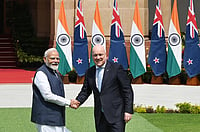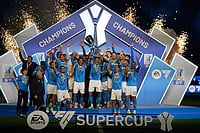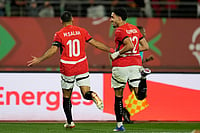THERE'S blood on the streets in the computer market. Price Wars I unfolded a year ago, and ended with the near-demise of PCL, the company that sparked off the mayhem. Price Wars II, the 1998 version, could end up being far bigger. The bazaar conditions this time are more complex, the desperation levels higher, the cast of characters large and stellar.
But first the wild card, who's come in from nowhere and thrown a twist into the proceedings just as the biggies were settling down to a good steady free-for-all. On April 6, Mumbai-based Zenith Computers announced that it was launching a multimedia personal computer (PC), for just Rs 33,500. Can Zenith do in the computer market what Akai has with its exchange schemes in the colour television sector? That is, catapult itself to a near-number one position in the industry? "MNC quality, Indian prices" is the Zenith line. The company also claims its machines have more features packed into them than any of its competitors—MNC or Indian. All it doesn't have is software, and of all the things a computer may not have, software is the one the average Indian buyer is least concerned about. He can still get a software pirate to pack every sort of software into a computer for less than Rs 1,000.
In fact, the 1998 computer price wars have been distinguished by not what computer makers are offering at a certain price tag, but what they are not offering. After all, the whole shebang began in early March, when Compaq, the world's largest PC maker, announced the launch of its Deskpro 1000 machines at under Rs 40,000. The catch: the monitor, which comes for Rs 10,000 or so, was not included in the price.
That set the cat among the pigeons. Rival companies got on Compaq's case. Claimed a full-page advertisement from Hewlett-Packard: "What you do not get for Rs 39,990 compared to HP Vectra for Rs 56,400." Then came the technical arguments: HP claimed it was offering SDRAM with Vectra while Compaq was offering Edo RAM, which was slowly being phased out in developed markets. Digital India too didn't let go the opportunity to take a dig at Compaq. Said its ad: "It always makes better sense to go to a vendor who gives you everything at a price that hides nothing." Ironically, Digital had just been bought by Compaq.
The advertisement from HCL, the country's largest computer company, was more direct. "Our ads include the price of the monitor," it said. Questions Sharad Talwar, marketing manager at HCL Infosystems, pointing at the Compaq advertisements: "Is a car ever sold without an engine?"
Compaq returned fire by releasing a statement which said Deskpro 1000 was being introduced in emerging markets in Europe, Asia Pacific and Latin America. Aha, said rivals, notice how Compaq has omitted Western Europe, the US or other developed markets. Compaq's statement said the company had decided to exclude the monitor since "in India too, we have seen this trend among other leading MNC players". Industry watchers, however, rubbish that claim.
BUT why point the finger at Compaq alone? Other vendors cried foul but their products including the monitor were not any cheaper. All the MNC brands are currently selling their computers for just under Rs 50,000, a price which does not include the multimedia kit. Add that, and the prices go closer to Rs 60,000. HCL offers a 1GB hard disk with a mono monitor and a Samsung printer for Rs 39,990. But who's buying a 1GB hard disk drive today? Want more disk space, pay more. Want a colour monitor, pay even more. A CD-ROM drive, pay much, much more. The estimated price for the HCL computer then goes well past the Rs 50,000 levels.
This is where Zenith wants to make a dent by providing its computers at a price which, as CEO Raj Saraf says, "will put a computer in every home, not on every office table". Hence the throwaway price of Rs 33,500.
But will Zenith go the PCL way? The company had launched computers at throwaway prices: the customer paid, and was supposed to get delivery in four weeks. PCL's strategy was to raise the cash first and then make the computers. The company was already reeling from a severe cash crunch, so this was a way to get out of that problem too. Didn't work. PCL's calculations turned out to be way off the mark, and it found itself unable to supply the computers for which it had already taken money. The entire company collapsed.
The other case is Sterling Computers, which undercut everyone else consistently in the late '80s, and then one day disappeared in the wake of its ever-thinning price tags. Zenith's Saraf, having spent nearly two decades in the computer industry, is only too aware of the PCL and Sterling stories. "We are not asking for any advance," he says. "You have the system delivered at your place and only then make the payment." Some industry observers say Compaq's move to start a price war may have been triggered off by the gloom surrounding its global operations. The company last month announced that sales had fallen short of its forecasts and profits may end up shorter by nearly 25 per cent compared to the last financial year. So, Compaq's Indian operations may also have been pushed to spike sales up. Also, after more than three years of setting up shop in India, Compaq may be getting impatient to grab the No 1 slot from HCL. HCL sells nearly 88,000 PCs a year; Compaq won't reveal its sales figures, but industry estimates peg it at around 30,000.
But the reasons may go deeper than that. PCs have increasingly become commoditi-sed, with no real difference between brands, since all of them anyway run on Intel-manufactured chips and Microsoft-designed software. The variation between one PC and another may simply be brand aura, and styling and design, where of course the larger brands are far ahead. So, branded PCs in India have always had a tough fight against unorganised sector assemblers who put together their machines in hole-in-the-wall workshops and sell at a price much lower than the big companies, with their much larger overheads, can afford. Chipmaker Intel Corporation has added another key twist by giving the assemblers credibility by titling them "genuine Intel dealers".
Assemblers, now empowered, and sporting "Intel Inside" stickers on their machines, have thus been able to reduce the brand choice question to a large extent to only one variable: price. So it may be Intel's move really which has forced Compaq and HP and every other biggie to cut prices, but they're still Rs 10,000 or so more expensive than the comparable unbranded PC.
The other factor is the huge potential market that is beginning to open up: the Indian home. Manufacturers expect their sales growth in the next few years to be powered significantly by the home market. And this market is price-sensitive.
Enter Zenith at Rs 33,500, lower than what "genuine Intel dealers" are offering. "This is the price for the next two months," says Saraf. "I don't know what'll happen after that. But we hope to sell 10,000 computers by then." Now wait for the big boys to respond.


























